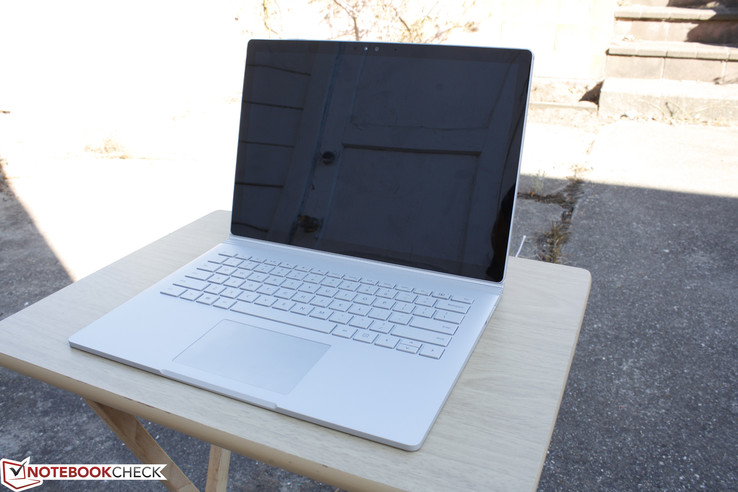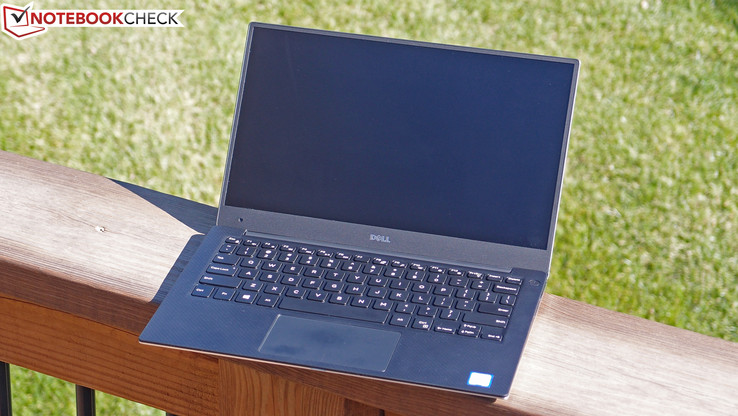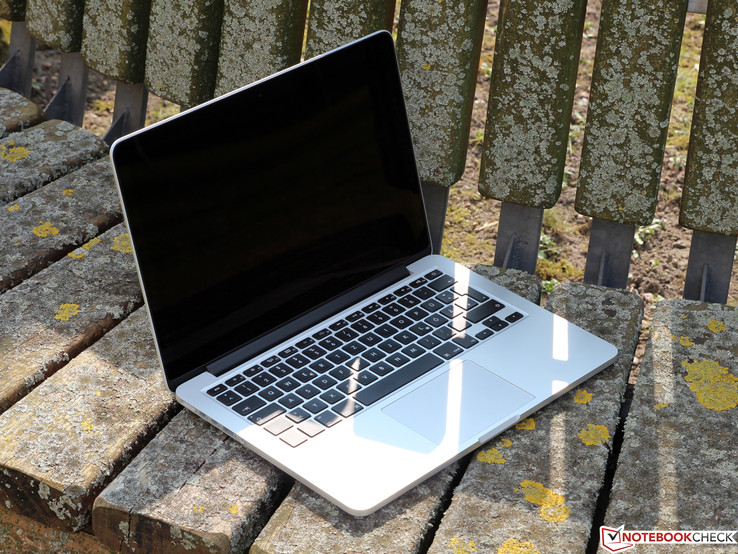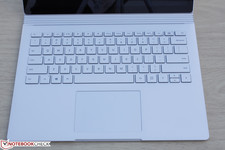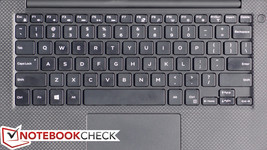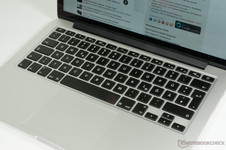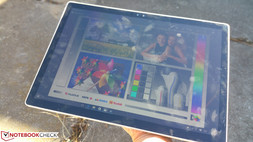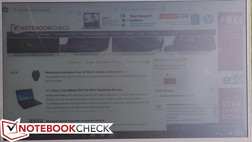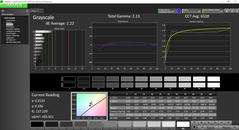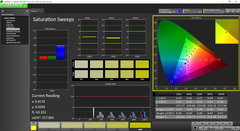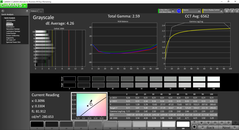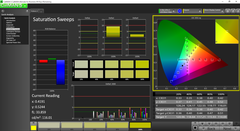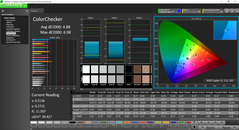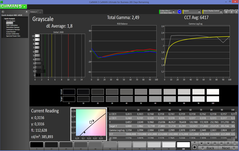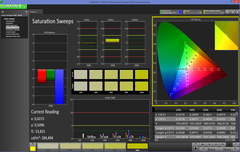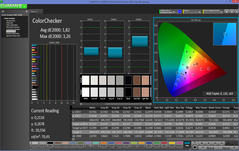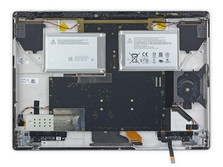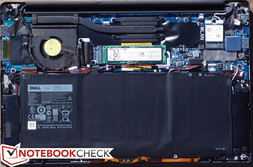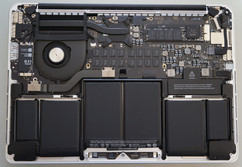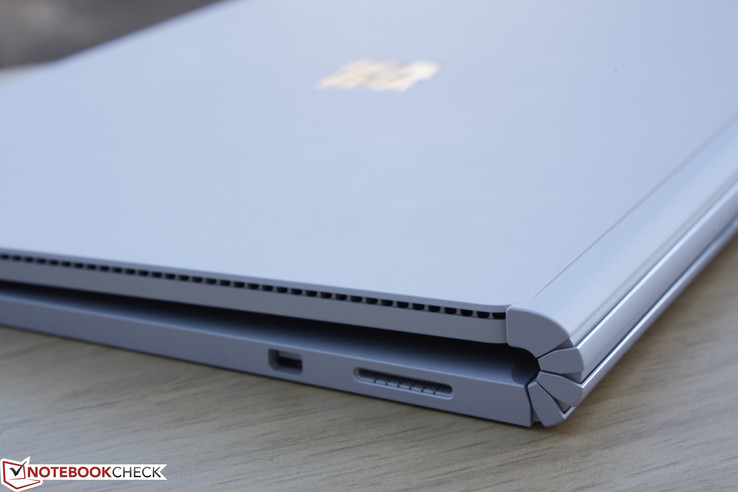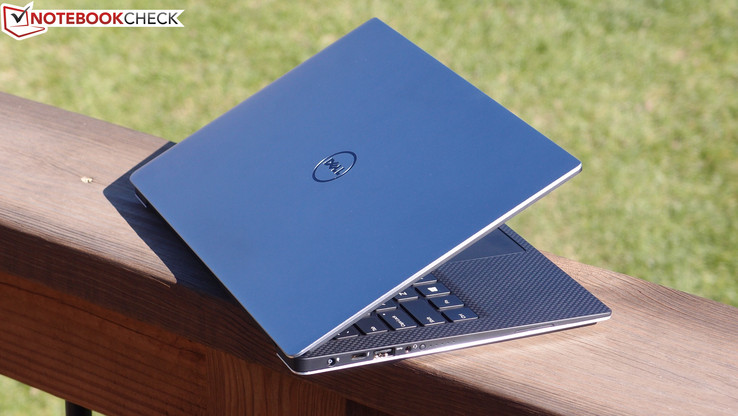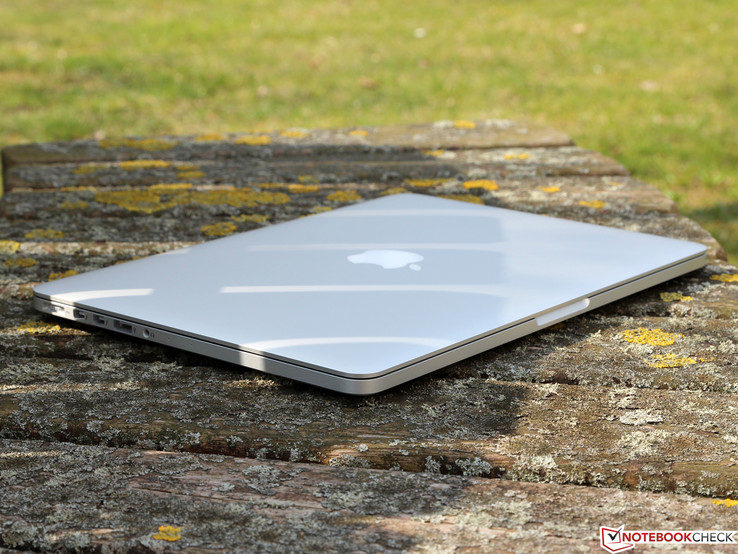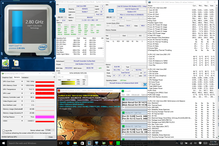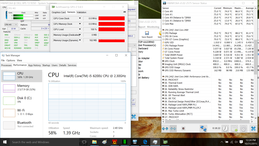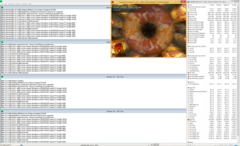Im Vergleich: Microsoft Surface Book vs. Dell XPS 13 InfinityEdge vs. Apple MacBook Pro Retina 13

Mit dem - erst vor kurzem auf dem Markt erschienenen - Surface Book hat Microsoft das Notebook gewissermaßen neu definiert. Wie wir in unserem Test veranschaulicht haben, ist das neue Gerät dank des Designs und der Hardware mehr als nur ein einfaches Convertible.
Vergleiche zwischen dem Surface Book und anderen populären 13-Zöllern drängen sich natürlich sofort auf. Wir sehen uns daher an, wie sich Microsofts Angebot vom neuesten XPS 13 InfinityEdge und dem MacBook Pro Retina 13 unterscheidet. Um unentschlossenen Lesern eine Entscheidung leichter zu machen, werden wir uns dabei primär auf die Hardware konzentrieren und nicht etwa auf das Aussehen oder die Software.
Wir empfehlen Ihnen in jedem Fall, auch die individuellen Testberichte zu lesen, da wir diese nicht ersetzen, sondern mit diesem Artikel allenfalls ergänzen wollen.
Test Dell XPS 13 InfinityEdge (Dell XPS 13 3/2015) (Dell XPS 13 2/2015) (Dell XPS 13 Touchscreen 2/2015) (Dell XPS 13 3/2014)
Test Apple MacBook Pro Retina 13 2015 (MacBook Pro Retina 13 2013)
Gehäuse
Mit dem MacBook Pro Retina 13 verlässt sich Apple auf Altbewährtes und lässt das Gehäuse unverändert. Das macht Sinn, da das Gerät sowieso ungemein stabil ist und keine wesentlichen Qualitätsschwachstellen aufweist. Das Unibody-MacBook ist für viele nach wie vor der Standard, an dem andere Ultrabooks gemessen werden.
Bei einem Gerät, das so ungewöhnlich wie das Surface Book ist, wäre es für Microsoft eigentlich ein Leichtes gewesen, gewissen Details - wie zum Beispiel den Spaltmaßen oder den üblichen Schwachstellen an der Basiseinheit - weniger Aufmerksamkeit zu schenken. Das ist aber nicht der Fall und das Gehäuse aus Aluminium ist sowohl überaus verwindungssteif als auch druckstabil. Dell verwendet mit Kohlefaser und Aluminium einen Materialmix, aber die Qualität des Ultrabooks ist dennoch um nichts niedriger.
Wie sollen wir hier dann einen Sieger küren, wenn die Qualität doch bei allen drei getesteten Geräten ausgezeichnet ist? Wir haben unsere Antwort letztendlich bei der Größe und beim Gewicht gefunden: das Surface Book ist das dickste Gerät, das mit 1,5 kg auch fast so schwer ist wie das MacBook Pro Retina 13 mit 1,56 kg. Der überaus dünne Bildschirmrahmen des XPS 13 InfinityEdge bringt eine reduzierte Grundfläche mit sich und damit auch ein geringeres Gewicht von nur 1,23 kg. Zugegebenermaßen ist das Gehäuse nicht ganz so verwindungssteif, aber das beeinträchtigt weder die Qualität noch die Langlebigkeit.
Der Größen- und Gewichtsvorteil des Dells machen die Vorteile, die das Surface Book und das MacBook in Sachen Stabiliät haben, wieder wett. Das XPS lässt sich zudem - sollte es einmal notwendig werden - auch einfacher warten.
Sieger: Dell XPS 13 InfinityEdge
Vergleich der Schnittstellen
Ausstattung
Was die Anschlüsse angeht, ist das Surface Book nicht übermäßig üppig ausgestattet. Es ist zwar nicht so, dass das XPS 13 und das MacBook viel mehr bieten - aber USB 3.1 Typ-C und Thunderbolt 2 sind doch etwas zukunftssicherer und flexibler als das, was Microsoft hier bietet.
Anders als beim Dell und beim Apple, ist ein einfacher Zugang zum M.2-Steckplatz beim Surface Book so gut wie nicht möglich. Keines der drei Geräte kann mit sekundären Massenspeichern ausgerüstet werden.
Das MacBook bietet zwar keinen USB Typ-C-Port, es ist aber sowohl mit HDMI als auch 2x Thunderbolt ausgerüstet und daher dem Dell geringfügig und dem Surface Book sogar weit überlegen.
Sieger: Apple MacBook Pro Retina 13
| Microsoft Surface Book | Dell XPS 13 InfinityEdge | Apple MacBook Pro Retina 13 | |
| USB | 2x USB 3.0 | 2x USB 3.0 | 2x USB 3.0 |
| Video-Out | 1x mDP | 1x USB 3.1 Typ-C Gen. 2 + Thunderbolt 3 | HDMI, 2x Thunderbolt 2 |
| Sonstiges | SD-Kartenleser, 1x 3.5 mm Audio | SD-Kartenleser, 1x 3,5 mm Audio, Kensington Lock | SD-Kartenleser, 1x 3.5 mm Combo, MagSafe 2 |
| Massenspeicher Steckplätze | 1x M.2 | 1x M.2 | 1x M.2 |
Eingabegeräte
Das Surface Book und das MacBook Pro Retina bieten komfortable Tastaturen mit gutem Feedback und Tastenhub. Insoweit werden individuelle Vorlieben bezüglich des Tastatur-Layouts und des Designs letztendlich die Wahl stärker beeinflussen. Das XPS hat eine Tastatur mit vergleichsweise geringem Tastenhub, obwohl das Feedback trotzdem grundsolide ist.
Alle drei Notebooks besitzen große Touchpads mit integrierten Tasten. Das Touchpad des Surface Book scheint nicht völlig ausgereift und reagiert manchmal nicht auf Eingaben. Das XPS hat mit solchen Problemen nicht zu kämpfen, aber interessanterweise fehlen ihm Treiber-Einstellungen, die es dem Benutzer ermöglichen würden, das Touchpad individuell den Bedürfnissen anzupassen. Apple hat in diesem Bereich mit "Force Touch" ein Ass im Ärmel und bietet einen ausgezeichneten Mausersatz mit vielen Konfigurationsmöglichkeiten.
Der vielleicht gravierendste Nachteil des MacBooks ist wohl, dass kein Touchscreen angeboten wird. Beim Surface Book ist ein solches Display Standard, beim XPS 13 ist es alternativ erhältlich.
Sieger: Tastatur: Unentschieden -- Microsoft Surface Book und Apple MacBook Pro Retina 13
Touchpad: Apple MacBook Pro Retina 13
Display
Abgesehen von offensichtlichen Unterschieden wie Auflösung und Seitenverhältnis, sind alle drei Displays ausgezeichnet und dem hohen Preis der Geräte angemessen. Vor die Aufgabe gestellt, das Beste auszuwählen, würden wir uns entweder für das Surface Book oder das MacBook entscheiden. Das erstgenannte hat eine höhere Leuchtstärke mit besserem Kontrast, das letztere kann mit einer höheren Farbgenauigkeit überzeugen, die eine Kalibrierung nicht notwendig erscheinen lässt.
| Microsoft Surface Book | Dell XPS 13 InfinityEdge | Apple MacBook Pro Retina 13 | |
| Größe | 13,5-Zoll IPS 3:2 | 13,3-Zoll IPS 16:9 | 13,3-Zoll IPS 16:10 |
| Auflösung | 3000 x 2000 | 1920 x 1080 | 2560 x 1600 |
| Pixeldichte | 267 PPI | 166 PPI | 227 PPI |
| Panel ID | Panasonic MEI96A2 | Sharp SHP1420 | Apple APPA02A |
| Panel | Glänzend | Matt | Glänzend |
Das Display des XPS 13 bildet hier das Schlusslicht, da es unseren Messungen zufolge nicht ganz so hell ist, obwohl der Hersteller 400 nits angibt. Dies st auch der automatischen Helligkeitskontrolle geschuldet, auf die der User (noch?) keinen Einfluss nehmen kann. Der Kontrast ist aber sehr gut und viele potentielle Kunden werden wahrscheinlich ein mattes Display einem glänzenden vorziehen. Die Farbgenauigkeit ist aber leider nicht sonderlich hoch und der Farbumfang kann weder mit dem Surface Book noch dem Macbook konkurrieren. Das XPS 13 steht alternativ auch mit einem hoch auflösenden QHD+ Touchdisplay zur Verfügung (hier im Test).
Sieger: Unentschieden -- Microsoft Surface Book
Apple MacBook Pro Retina 13
| Microsoft Surface Book Core i5 | Dell XPS 13-9350 | Apple MacBook Pro Retina 13 inch 2015-03 | |
|---|---|---|---|
| Display | |||
| Display P3 Coverage (%) | 67 | 44.53 | 65.9 |
| sRGB Coverage (%) | 95.8 | 66.8 | 97 |
| AdobeRGB 1998 Coverage (%) | 68.9 | 45.97 | 67.4 |
| Response Times | |||
| Response Time Grey 50% / Grey 80% * (ms) | 48.4 ? | ||
| Response Time Black / White * (ms) | 32.8 ? | ||
| PWM Frequency (Hz) | |||
| Bildschirm | |||
| Helligkeit Bildmitte (cd/m²) | 430.9 | 277.5 | 361 |
| Brightness (cd/m²) | 410 | 276 | 342 |
| Brightness Distribution (%) | 93 | 88 | 81 |
| Schwarzwert * (cd/m²) | 0.254 | 0.191 | 0.361 |
| Kontrast (:1) | 1696 | 1453 | 1000 |
| Delta E Colorchecker * | 2.06 | 4.88 | 1.82 |
| Delta E Graustufen * | 2.22 | 4.26 | 1.8 |
| Gamma | 2.13 103% | 2.59 85% | 2.49 88% |
| CCT | 6520 100% | 6562 99% | 6417 101% |
| Farbraum (Prozent von AdobeRGB 1998) (%) | 64 | 41.6 | 61.9 |
| Color Space (Percent of sRGB) (%) | 96 | 65.79 | 96.9 |
| Colorchecker dE 2000 max. * | 3.26 | ||
| Durchschnitt gesamt (Programm / Settings) |
* ... kleinere Werte sind besser
Leistung
Prozessor
Obwohl Microsoft, Dell und Apple alle zusätzliche CPUs im Angebot haben, werden wir uns in unserem Vergleich nur auf die Konfiguration der vorliegenden Testgeräte beschränken.
Trotz der unterschiedlichen CPU-Generation (Apple: Broadwell, Surface und XPS 13: Skylake) liegen all drei Notebooks bei der Prozessorleistung fast gleichauf. Das Gerät von Apple kann dank des geringfügig höheren Turbo-Boosts (3,1 GHz vs. 2,9 GHz und 2,8 GHz beim i5-6300U bzw. i5-6200U) einen hauchdünnen Vorsprung einfahren. Ein Otto Normalverbraucher wird im Alltagsbetrieb allerdings keine Unterschiede feststellen können.
Mehr über diverse Leistungsvergleiche und Benchmarks erfahren Sie auf den spezifischen Seiten für den i5-6200U, i5-6300U und den i5-5257U.
| Microsoft Surface Book | Dell XPS 13 InfinityEdge | Apple MacBook Pro Retina 13 | |
| CPU | 2.4 GHz Core i5-6300U | 2.3 GHz Core i5-6200U | 2.7 GHz Core i5-5257U |
| TDP | 15 W | 15 W | 28 W |
| RAM | 8 GB DDR3 1066.7 MHz, Dual-Channel, verlötet | 8 GB LPDDR3 1867 MHz, Dual-Channel, verlötet | 8 GB LPDDR3, Dual-Channel, verlötet |
| GPU | Spezieller Nvidia GPU + Intel HD Graphics 520 | Intel HD Graphics 520 | Intel Iris Graphics 6100 |
| Cinebench R10 | |
| Rendering Single CPUs 64Bit (nach Ergebnis sortieren) | |
| Microsoft Surface Book Core i5 | |
| Dell XPS 13-9350 | |
| Apple MacBook Pro Retina 13 inch 2015-03 | |
| Rendering Multiple CPUs 64Bit (nach Ergebnis sortieren) | |
| Microsoft Surface Book Core i5 | |
| Dell XPS 13-9350 | |
| Apple MacBook Pro Retina 13 inch 2015-03 | |
| wPrime 2.10 | |
| 1024m (nach Ergebnis sortieren) | |
| Microsoft Surface Book Core i5 | |
| Dell XPS 13-9350 | |
| 32m (nach Ergebnis sortieren) | |
| Microsoft Surface Book Core i5 | |
| Dell XPS 13-9350 | |
| Super Pi Mod 1.5 XS 32M - 32M (nach Ergebnis sortieren) | |
| Microsoft Surface Book Core i5 | |
| Dell XPS 13-9350 | |
| Apple MacBook Pro Retina 13 inch 2015-03 | |
| 3DMark | |
| 1280x720 offscreen Ice Storm Unlimited Physics (nach Ergebnis sortieren) | |
| Microsoft Surface Book Core i5 | |
| Apple MacBook Pro Retina 13 inch 2015-03 | |
| 1920x1080 Ice Storm Extreme Physics (nach Ergebnis sortieren) | |
| Microsoft Surface Book Core i5 | |
| Apple MacBook Pro Retina 13 inch 2015-03 | |
| 1280x720 Cloud Gate Standard Physics (nach Ergebnis sortieren) | |
| Microsoft Surface Book Core i5 | |
| Dell XPS 13-9350 | |
| Apple MacBook Pro Retina 13 inch 2015-03 | |
| 1920x1080 Fire Strike Physics (nach Ergebnis sortieren) | |
| Microsoft Surface Book Core i5 | |
| Dell XPS 13-9350 | |
| Apple MacBook Pro Retina 13 inch 2015-03 | |
| Fire Strike Extreme Physics (nach Ergebnis sortieren) | |
| Microsoft Surface Book Core i5 | |
| Apple MacBook Pro Retina 13 inch 2015-03 | |
* ... kleinere Werte sind besser
Grafikleistung
Anders als bei den nahezu identischen CPUs hat Microsoft bei der Grafikleistung eindeutig die Nase vorn. Die spezielle Nvidia Maxwell GPU ist im Wesentlichen eine GeForce GT 940M, die laut 3DMark 11 die Leistung der Iris Graphics 6100 um 30 Prozent und die der HD Graphics 520 um 40 Prozent übertrifft.
Das Dell-Gerät hat das Nachsehen, da die Iris Graphics im 3DMark 11 ca. 20 Prozent und im 3DMark Fire Strike um 10 Prozent schneller ist.
| 3DMark 11 - 1280x720 Performance GPU (nach Ergebnis sortieren) | |
| Microsoft Surface Book Core i5 | |
| Dell XPS 13-9350 | |
| Apple MacBook Pro Retina 13 inch 2015-03 | |
| 3DMark | |
| 1280x720 offscreen Ice Storm Unlimited Graphics Score (nach Ergebnis sortieren) | |
| Microsoft Surface Book Core i5 | |
| Apple MacBook Pro Retina 13 inch 2015-03 | |
| 1920x1080 Ice Storm Extreme Graphics (nach Ergebnis sortieren) | |
| Microsoft Surface Book Core i5 | |
| Apple MacBook Pro Retina 13 inch 2015-03 | |
| 1280x720 Cloud Gate Standard Graphics (nach Ergebnis sortieren) | |
| Microsoft Surface Book Core i5 | |
| Dell XPS 13-9350 | |
| Apple MacBook Pro Retina 13 inch 2015-03 | |
| 1920x1080 Fire Strike Graphics (nach Ergebnis sortieren) | |
| Microsoft Surface Book Core i5 | |
| Dell XPS 13-9350 | |
| Apple MacBook Pro Retina 13 inch 2015-03 | |
| Fire Strike Extreme Graphics (nach Ergebnis sortieren) | |
| Microsoft Surface Book Core i5 | |
| Apple MacBook Pro Retina 13 inch 2015-03 | |
| Cinebench R11.5 - OpenGL 64Bit (nach Ergebnis sortieren) | |
| Microsoft Surface Book Core i5 | |
| Dell XPS 13-9350 | |
| Apple MacBook Pro Retina 13 inch 2015-03 | |
| Apple MacBook Pro Retina 13 inch 2015-03 | |
| Cinebench R15 - OpenGL 64Bit (nach Ergebnis sortieren) | |
| Microsoft Surface Book Core i5 | |
| Dell XPS 13-9350 | |
| Apple MacBook Pro Retina 13 inch 2015-03 | |
Gaming-Leistung
Intels Iris Grafikkarte kann sich von der HD 520 bei den synthetischen Benchmarks immer recht deutlich absetzen. Beim Gaming selbst ist der Unterschied aber nicht so groß, wie man bei unserem Test mit Bioshock Infinite sehen kann. Die dedizierte Nvidia GPU stellt aber die beiden anderen Lösungen in den Schatten und verspricht ein wesentlich besseres Spielerlebnis.
Weitere Informationen und Benchmarks stehen auf den Spezialseiten für die Grafikkarten - Surface Book GPU, HD 520 und Iris Pro 6100 - zur Verfügung.
| BioShock Infinite | |
| 1920x1080 Ultra Preset, DX11 (DDOF) (nach Ergebnis sortieren) | |
| Microsoft Surface Book Core i5 | |
| Dell XPS 13-9350 | |
| Apple MacBook Pro Retina 13 inch 2015-03 | |
| 1366x768 High Preset (nach Ergebnis sortieren) | |
| Microsoft Surface Book Core i5 | |
| Dell XPS 13-9350 | |
| Apple MacBook Pro Retina 13 inch 2015-03 | |
| 1366x768 Medium Preset (nach Ergebnis sortieren) | |
| Microsoft Surface Book Core i5 | |
| Dell XPS 13-9350 | |
| Apple MacBook Pro Retina 13 inch 2015-03 | |
| 1280x720 Very Low Preset (nach Ergebnis sortieren) | |
| Microsoft Surface Book Core i5 | |
| Dell XPS 13-9350 | |
| Apple MacBook Pro Retina 13 inch 2015-03 | |
Stresstest
Um die System-Stabilität zu überprüfen, belasten wir unsere Testsysteme mit den Tools Prime95 und Furmark. Solche unrealistische Bedingungen sind im normalen Alltag nicht zu erwarten, sondern dienen nur dazu, den Prozessor und die GPU hundertprozentig auszulasten.
Das Surface Book bewältigt den Stresstest sehr gut und nutzt den maximalen Turbo-Boost für die CPU voll aus; die GPU stabilisiert sich ganz geringfügig unter der Nominalfrequenz. Die Geräte von Dell und Apple reduzieren den Takt des Prozessors auf 1,4 beziehungsweise 1,8 GHz, also ganz deutlich unter der respektiven Normalfrequenz. Die Taktfrequenz der Grafikkarten brechen weitaus weniger ein - die CPUs sind also die Hauptleidtragenden, was das Throttling anbelangt.
Die CPU im MacBook übertrifft die 100-Grad-Marke, was dann doch etwas besorgniserregend ist. Das XPS 13 und das Surface Book erreichen im Vergleich nur 87 und 89 Grad Celsius.
Sieger: Microsoft Surface Book
| Microsoft Surface Book | Dell XPS 13 InfinityEdge | Apple MacBook Pro Retina 13 | |
| Nennfrequenz GPU (MHz) | 954 | 300 | 300 - 1050 |
| Stabile GPU-Frequenz FurMark (MHz) | 745 - 823 | 850 | 800 |
| <Nennfrequenz CPU (GHz) | 2,4 | 2,3 | 2,7 |
| Stabile CPU-Frequenz Prime95 (GHz) | 2,8 - 2,9 | 1,4 | 1,8 |
| Maximale Temperatur CPU | 89 C | 87 C | 90 - 100 C |
| Maximale Temperatur GPU | 76 C | -- | -- |
Emissionen
Geräuschemissionen & Temperatur
Die Lüfter der drei Modelle bleiben bei geringer Auslastung so gut wie unhörbar. Das Notebook von Dell ist im Vergleich mit dem Surface Book und dem MacBook - beide erreichen >40 dB(A) - mit 30 dB(A) bei Maximalbelastung sehr leise.
Die Oberflächentemperaturen der drei Kontrahenten liegen sowohl im Idle-Betrieb als auch unter Last überraschenderweise fast gleichauf. Bei Maximalbelastung erreicht die Unterseite bei allen drei ungefähr 45 Grad Celsius. Die Tastatur des Dells wird bei größerer Belastung und Höchstlast allerdings etwas wärmer als die des Surface Books oder des MacBooks. Es ist aber eigentlich doch beeindruckend, wie das Dell mit gleichwertigen Oberflächentemperaturen aufwarten kann - und das obwohl es weniger leiser und zudem noch kleiner ist.
Sieger: Dell XPS 13 InfinityEdge
| Microsoft Surface Book | Dell XPS 13 InfinityEdge | Apple MacBook Pro Retina 13 | |
| Lüfter im Idle-Betrieb | 29,6 dB(A) | 28,3 dB(A) | 29,0 dB(A) |
| Lüfter Hochlast | 37,5 - 40,9 dB(A) | 30,2 dB(A) | 42 - 45 dB(A) |
| Durchschnittliche Oberflächentemperatur im Idle-Betrieb | 23,8 C (Basis Tastatur) | 27,3 C | 27,6 C |
| Durchschnittliche Oberflächentemperatur Hochlast | 33,3 C (Basis Tastatur) | 34,3 C | 33,8 C |
| Umgebungstemperatur | 20,5 C | 20,5 C | 20,0 C |
Akkulaufzeit
Die Laufzeiten des Surface Books sind auch mit angedockter Tastatur vergleichsweise gering. Das kann auf fehlendes Optimus zurückzuführen sein, da die dGPU automatisch aktiviert wird, wenn die Tastatur angesteckt wird. Das MacBook hat eine Batterie mit größerer Kapazität und hält im WLAN-Test dann auch länger durch. Unter Last ist die Laufzeit dann allerdings etwas kürzer, was zumindest teilweise auf die CPU zurückzuführen ist, die etwas leistungshungriger ist.
Die untenstehenden Laufzeiten sind in Minuten angeführt.
Sieger: Apple MacBook Pro Retina 13
| Microsoft Surface Book Core i5 69 Wh | Dell XPS 13-9350 56 Wh | Apple MacBook Pro Retina 13 inch 2015-03 75 Wh | |
|---|---|---|---|
| Akkulaufzeit | |||
| Idle (h) | 17.8 | 13 | 28.2 |
| WLAN (h) | 6.7 | 7.5 | 9 |
| Last (h) | 2.6 | 2.5 | 1.6 |
Fazit
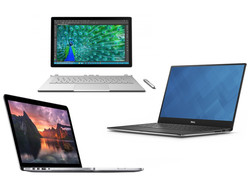
Die Vor- und Nachteile der drei Geräte liegen vielschichtig, also können wir hier nicht - da wir ja objektiv bleiben wollen - eine klare Empfehlung aussprechen. Das XPS 13 hat eindeutige Vorteile, was das Gewicht und die Größe anbelangt, aber wir sind von der maximalen Leuchtstärke des Displays etwas enttäuscht, da wir laut Dell vom 1080p-Panel mehr erwarten dürfen. Das außergewöhnliche Surface Book ist als 2-in-1 auch sehr attraktiv und glänzt überdies mit überraschend guter Performance, obwohl es durch die mangelnde Anschlussvielfalt nicht ganz so flexibel ist. Das Bildschirmformat von 3:2 liegt wahrscheinlich auch nicht jedem.
Apple macht beim MacBook Pro 13 alles Notwendige richtig und rüstet das Gerät mit einem hellen Display mit hoher Farbgenauigkeit aus. Ein normaler HDMI-Anschluss ist auch dabei und die Laufzeiten können sich sehen lassen. Obwohl das MacBook sicher nicht zu groß oder zu schwer ist, bietet das XPS 13 USB 3.1 Type-C mit Thunderbolt 3 - und ist dabei um einiges kleiner. Da die Verarbeitungsqualität auf Augenhöhe liegt und auch die Langlebigkeit kein Faktor bei der Auswahl sein sollte, liegt man unserer Meinung nach bei jedem der drei Geräte richtig - es kommt auf die individuellen Bedürfnisse und Vorlieben des Users an.
| Microsoft Surface Book | Dell XPS 13 InfinityEdge | Apple MacBook Pro Retina 13 |
|---|---|---|
+ Gehäuse aus einer Aluminum-Legierung; Ausgezeichnete Verarbeitungsqualität + "Detachable" mit Surface Pen + gute Performance im Stresstest + diskrete Nvidia Grafikkarte | + Gehäuse aus Aluminium und Kohlefaser; Ausgezeichnete Verarbeitungsqualität + wesentlich leichter und kleiner + mattes Display im Angebot + USB 3.1 Type-C Gen. 2 mitThunderbolt 3 + sehr leise + M.2 SSD kann aufgerüstet werden | + Gehäuse aus einer Aluminum-Legierung; Ausgezeichnete Verarbeitungsqualität + helles Display mit hoher Farbgenauigkeit + "Force Touch" Trackpad + HDMI and 2x Thunderbolt 2 + lange Laufzeiten + M.2 SSD kann aufgerüstet werden |
- schwerer - dicker - geringere Anschlussvielfalt - Wartung und Reparatur nicht einfach - Akkulaufzeiten gering | - CPU-Throttling unter Höchstlast - Display nicht so hell; Geringere Farbgenauigkeit - Tastenhub kürzer | - schwerer - Touchscreen wird nicht angeboten - CPU-Throttling unter Höchstlast - höheres Temperaturniveau - Lüfter ist lauter |
Preisvergleich Microsoft Surface Book
Preisvergleich
Preisvergleich Dell XPS 13 InfinityEdge
Preisvergleich
Preisvergleich Apple MacBook Pro Retina 13
Preisvergleich
Weitere Berichte in unserer Vergleichs-Serie (teilweise Englisch):
- Dell XPS 15 vs. Apple MacBook Pro 15 vs. Asus ZenBook Pro UX501
- Aorus X3 Plus vs. Gigabyte P34W vs. Razer Blade 14
- Dell XPS 13 vs. Apple MacBook Pro 13 vs. Asus ZenBook UX305
- HP EliteBook 820 G2 vs. Lenovo ThinkPad X250 vs. Dell Latitude 12 E7250
- Asus ROG G751 vs. Dell Alienware 17 vs. MSI GT72 Dominator
- Lenovo ThinkPad T450 vs. Acer TravelMate P645 vs. Dell Latitude 14 E5450
- Dell Alienware 15 vs. Clevo P751ZM vs. MSI GE62
- Acer Aspire V17 Nitro vs. Asus N751 vs. HP Envy 17
- Samsung Galaxy Tab S 8.4 vs. Sony Xperia Z3 Compact vs. Dell Venue 8 7000
- Asus EeeBook X205TA vs. Lenovo S20 vs. Acer Aspire ES1
- Microsoft Surface Pro 3 vs. Asus Transformer Book T300 Chi vs. Toshiba Portege Z20t
- Lenovo ThinkPad Edge E550 vs. Acer Aspire E5 vs. HP ProBook 450 G2
- HP Pavilion 15 vs. Lenovo IdeaPad Z50 vs. Toshiba Satellite S50
- Apple MacBook Air 13 2015 vs. Samsung ATIV Book 9 900X3G vs. Asus ZenBook UX303
- Asus ROG G501 vs. Lenovo Y50 vs. Acer Aspire V15 Nitro
- OnePlus 2 vs. Honor 6 Plus vs. Motorola Moto X Play
- Lenovo Yoga 500 vs. Dell Inspiron 15 7000 vs. Toshiba Satellite Radius 15
- Apple iPhone 6S Plus vs. Huawei Mate S vs. LG G4
- Dell Inspiron 15 5558 vs. Lenovo Z51 vs. Acer Aspire V3 574G
- MSI GT72S vs. Asus G752 vs. Clevo P870DM


